How To Prepare Your Lawn For Cold Weather
People in the Midwest are enjoying the higher-than-average temperatures as the November days tick by, but we shouldn’t get too comfortable. Even though we’re experiencing a warmer-than-normal Fall, it appears we could be in for a doozy of a Winter.
The Farmer’s Almanac and many other weather news sources warn that the Midwest will be hit with severe Winter activity. According to the Farmer’s Almanac:
“Winter for much of the Midwest and along the East Coast is best described as “Shivery & Snowy.”
- Winter temperatures will be colder than normal across much of the country between the East Coast and the Rockies.
- Snowfall will be greater than normal…from the Lower Great Lakes and the Ohio and Tennessee Valleys into the southern Plains.”
Undoubtedly, this means stocking up on ice melt, making sure there’s an ice scraper in your car, and getting that snowblower fired up and running. Plus, checking the snow shovel in the garage to see if it needs replacing. Taking care of these things now can save you some money and frustration down the road when they’re in higher demand and harder to find.
Prepping for upcoming Winter weather in these ways is essential, but don’t overlook prepping your yard for the colder temperatures and heavy snowfalls too. It might seem strange to do yard work just before the lawn goes dormant, but a healthy lawn as we head into Winter results in a better lawn come Spring.
Remove Leaves From Your Lawn
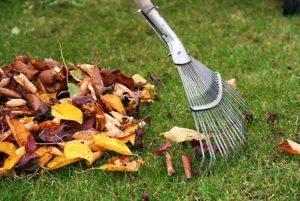
- Before your grass goes dormant, you want grass leaves to get as much sun as possible so they store plenty of food reserves in their roots. Greater food reserves help the grass survive through the Winter.
- Leaves packed under snow for months are not only a haven for insects, and diseases, but they are also miserable to clean up come Spring.
With this in mind, it’s best to clean up the leaves as soon as possible!
Fertilize Cool-Season Grass
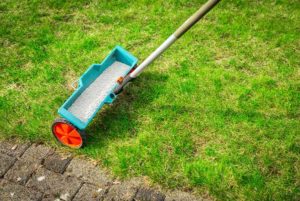
In the Fall, your grass is recovering from the heat of Summer and preparing for the upcoming Winter. It is the perfect time to give it a boost of nutrients to help it rebound from Summer stress and build stamina to get it through until Spring.
This fertilization helps it to weather the Winter by building reserves in:
- Nitrogen, which prompts leaf blade development and improved turf density. This results in more food stores and better green-up in the Spring.
- Potassium, which helps the grass tolerate environmental stressors better, strengthening it for the cold weather.
- Phosphorus increases root growth and helps move energy reserves to the roots for storage.
You want to apply a high-nitrogen fertilizer (30-0-4 or 25-5-5) or a balanced formula like 12-12-12 as soon as possible. It’s best to fertilize before the blades start browning so that your grass will still reap benefits as early as possible.
Don’t Fertilize Warm-Season Grass
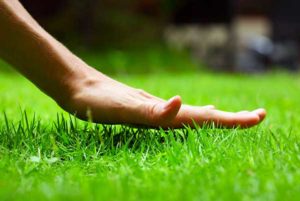
In late Fall, warm-season grasses only need a dose of potassium, they don’t need large amounts of nitrogen to prepare for a cold Winter. A high application of nitrogen triggers the grass to grow vegetatively instead of preparing for dormancy.
For those with warm-season grasses, here is a recommended fertilizer protocol.
- Apply a high potassium production such as 0-0-18 (potash) or 4-3-20.
- Apply no more than 1 pound of potassium per 1000 square feet of lawn.
- Apply fertilizer when growth begins to slow, but the blades are still green. At this time, the roots are still active and more receptive to nutrients.
Fall Lawn Aeration
After mowing your grass all Summer and having kids and pets running across it, there’s a good chance the soil has compacted to some degree. Aerating cool-season grasses in Fall reduces this soil compaction so water, air, and nutrients (especially that Fall fertilization) move through the soil and improve grass growth.
There are two different ways to aerate—spike and core aeration. Core aeration provides the best results as it physically pulls small plugs of soil and grass from the lawn. These holes reduce the soil compaction and improve gas and water exchange. You can rent an aerator to make it a DIY project or hire a professional lawn aeration service. If possible, aerate before fertilizing so the fertilizer can easily get into the soil.
Watering Your Lawn In The Fall
One of homeowners’ biggest mistakes during the autumn months is to stop watering their grass. Your lawn grows even as temperatures drop, so you must continue to water it regularly. It uses this water to bounce back from the Summer heat and help prepare for dormancy.
It is recommended to continue your regular watering schedule, giving your lawn one inch of water every week through irrigation or natural rainfall. Once the grass turns brown, you can alter this schedule to one inch every ten to fourteen days. When you start having consistent freezing temperatures, it’s time to stop watering.
Keep Mowing Until Grass Goes Dormant
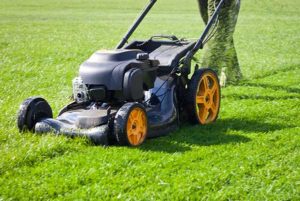
As regular frost or snow becomes imminent, adjust the mower deck to a height based on your grass type.
Trim Large Trees
Moving past your grass, Fall is also the ideal time to trim your trees. Especially ones with large, heavy branches that hang close to your house or garage. Heavy, wet snow (which the forecast is calling for) can cause these branches to crack under excess weight. Trimming them before problems occur can avoid costly insurance claims over Winter.
Spot Treat With Weed Killer
During the Fall, your grass rapidly moves resources from its blades to the roots for Winter storage. Because of this, it’s an ideal time to spot-treat problematic weeds. After application, the herbicide is translocated through the plant, killing the weed much more effectively.
Also, if you address weed problems in the Fall, your grass has less competition come Spring and will take over when growth resumes.
Throw Down Grass Seed
Fall is also a good time to rejuvenate a thinning lawn or fix unsightly bare spots with new grass seed. Overseeding right now helps reduce the chance weeds will move in and take over, and the seed germinates quickly and grows well when the temperatures are cooler.
Replenish Worn Out Mulch
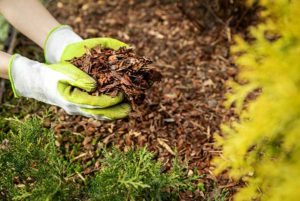
Stay Off the Lawn When It’s Too Wet
Lastly, if Fall precipitation makes your soil soggy, stay off the lawn as much as possible. Walking across the ground when it’s full of water can compact the soil, which defeats the money and time you already spent on aeration!
You should also avoid raking when it’s too wet as this will risk pulling your grass out by the roots.
Need Help Preparing Your Lawn For Cold Weather?
We understand that Fall is a busy time of year, and you may have more on your to-do list than you have time to accomplish. If that’s the case, let the professionals at Ryan Lawn & Tree help! Our trained service experts can ease your burden by fertilizing, aerating, treating weeds, trimming trees, and much more! Contact us today for your Free Estimate!









